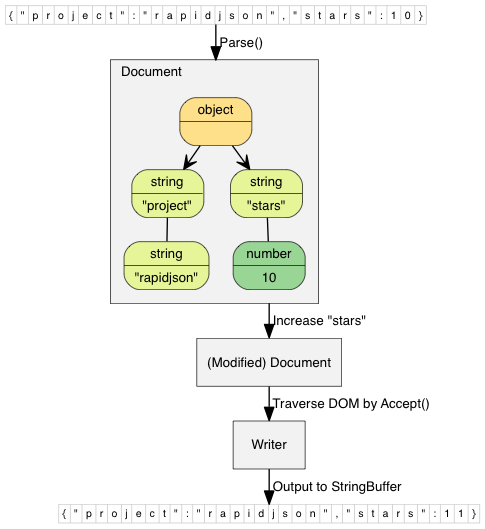1
2
3
4
5
6
7
8
9
10
11
12
13
14
15
16
17
18
19
20
21
22
23
24
25
26
27
28
29
30
31
32
33
34
35
36
37
38
39
40
41
42
43
44
45
46
47
48
49
50
51
52
53
54
55
56
57
58
59
60
61
62
63
64
65
66
67
68
69
70
71
72
73
74
75
76
77
78
79
80
81
82
83
84
85
86
87
88
89
90
91
92
93
94
95
96
97
98
99
100
101
102
103
104
105
106
107
108
109
110
111
112
113
114
115
116
117
118
119
120
121
122
123
124
125
126
127
128
129
130
131
132
133
134
135
136
137
138
139
140
141
142
143
144
145
146
147
148
149
150
151
152
153
154
155
156
157
158
159
160
161
162
163
164
165
166
167
168
169
170
171
172
173
174
175
176
177
178
179
180
181
182
183
184
185
186
187
188
189
190
191
|
#include "../../RapidJson/prettywriter.h"
#include <cstdio>
#include <string>
#include <vector>
using namespace rapidjson;
class Person {
public:
Person(const std::string &name, unsigned age) : name_(name), age_(age) {}
Person(const Person &rhs) : name_(rhs.name_), age_(rhs.age_) {}
virtual ~Person();
Person &operator=(const Person &rhs) {
name_ = rhs.name_;
age_ = rhs.age_;
return *this;
}
protected:
template<typename Writer>
void Serialize(Writer &writer) const {
writer.String("name");
#if RAPIDJSON_HAS_STDSTRING
writer.String(name_);
#else
writer.String(name_.c_str(), static_cast<SizeType>(name_.length()));
#endif
writer.String("age");
writer.Uint(age_);
}
private:
std::string name_;
unsigned age_;
};
class Education {
public:
Education(const std::string &school, double GPA) : school_(school), GPA_(GPA) {}
Education(const Education &rhs) : school_(rhs.school_), GPA_(rhs.GPA_) {}
Education &operator=(const Education &rhs) {
school_ = rhs.school_;
GPA_ = rhs.GPA_;
return *this;
}
template<typename Writer>
void Serialize(Writer &writer) const {
writer.StartObject();
writer.String("school");
#if RAPIDJSON_HAS_STDSTRING
writer.String(school_);
#else
writer.String(school_.c_str(), static_cast<SizeType>(school_.length()));
#endif
writer.String("GPA");
writer.Double(GPA_);
writer.EndObject();
}
private:
std::string school_;
double GPA_;
};
class Dependent : public Person {
public:
Dependent(const std::string &name, unsigned age, Education *education = 0) : Person(name, age),
education_(education) {}
Dependent(const Dependent &rhs) : Person(rhs), education_(nullptr) {
education_ = (rhs.education_ == 0) ? 0 : new Education(*rhs.education_);
}
~Dependent();
Dependent &operator=(const Dependent &rhs) {
if (this == &rhs)
return *this;
delete education_;
education_ = (rhs.education_ == 0) ? 0 : new Education(*rhs.education_);
return *this;
}
template<typename Writer>
void Serialize(Writer &writer) const {
writer.StartObject();
Person::Serialize(writer);
writer.String("education");
if (education_)
education_->Serialize(writer);
else
writer.Null();
writer.EndObject();
}
private:
Education *education_;
};
class Employee : public Person {
public:
Employee(const std::string &name, unsigned age, bool married) : Person(name, age), married_(married) {}
Employee(const Employee &rhs) : Person(rhs), dependents_(rhs.dependents_), married_(rhs.married_) {}
virtual ~Employee();
Employee &operator=(const Employee &rhs) {
if (this == &rhs)
return *this;
static_cast<Person &>(*this) = rhs;
dependents_ = rhs.dependents_;
married_ = rhs.married_;
return *this;
}
void AddDependent(const Dependent &dependent) {
dependents_.push_back(dependent);
}
template<typename Writer>
void Serialize(Writer &writer) {
writer.StartObject();
Person::Serialize(writer);
writer.String("married");
writer.Bool(married_);
writer.String("dependents");
writer.StartArray();
for (const auto &item: dependents_)
item.Serialize(writer);
writer.EndArray();
writer.EndObject();
}
private:
std::vector<Dependent> dependents_;
bool married_;
};
int testSerial();
#include "../../../Header/example/serial/serial.h"
Dependent::~Dependent() {
delete education_;
}
Person::~Person() {}
Employee::~Employee() {}
int testSerial() {
std::vector<Employee> employees;
employees.push_back(Employee("Lihua", 34, true));
employees.back().AddDependent(Dependent("Lua", 3, new Education("Happy Kindergarten", 3.5)));
employees.back().AddDependent(Dependent("Mio", 1));
employees.push_back(Employee("Percy", 30, false));
StringBuffer sb;
PrettyWriter<StringBuffer> writer(sb);
writer.StartArray();
for (auto &item: employees)
item.Serialize(writer);
writer.EndArray();
puts(sb.GetString());
return 0;
}
|
